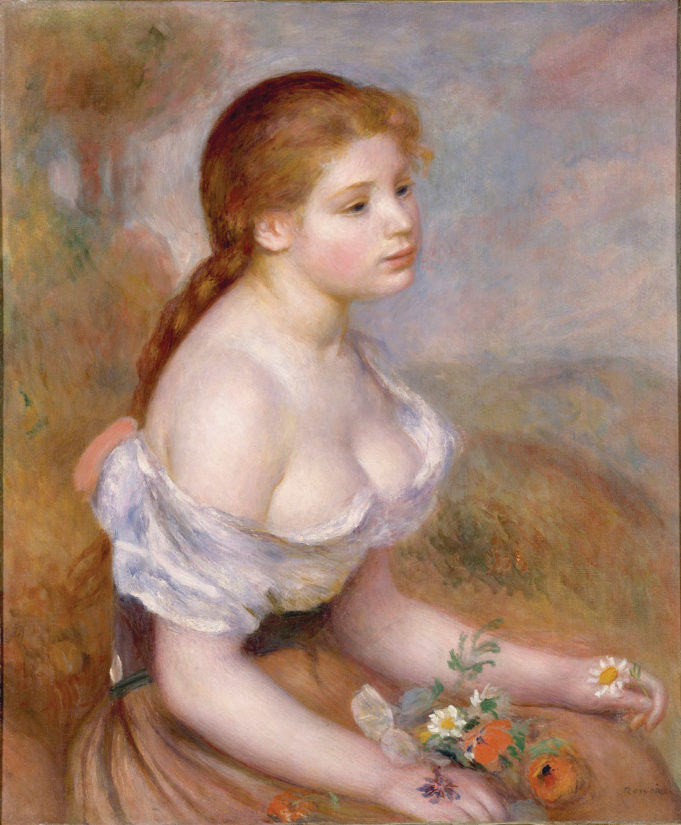Sure, it’s easy to claim a glib knowledge of Pierre-Auguste Renoir with a recitation of his ubiquitous renditions of women boasting abundant folds of pink flesh.
But beyond all this familiarity lurks a steamer trunk full of nuance and substance that informs Renoir’s devotion to the roseate-tinted human form – all of which has inspired the Kimbell Art Museum’s latest exhibition. Renoir: The Body, The Senses serves as an essential display of the French painter’s under-appreciated sophistication and nonconformist approach to his sensual subjects.
The Kimbell makes museum history with the first ever important exhibition concentrating on Renoir’s evolutionary treatment of the nude. Marking the 100th anniversary of the painter’s death, the show packs heft by offering more than 60 drawings, paintings, sculptures, and pastels.
With Kimbell deputy director George T.M. Shackelford collaborating with Esther Bell, chief curator of the show’s first venue, the Clark Art Institute of Williamstown, Massachusetts, Renoir: The Body, The Senses presents some of Renoir’s most beloved celebrations of barely clothed female forms. And through the shrewd inclusion of works by Degas, Boucher, and Picasso, it draws essential conclusions about who influenced Renoir and how loftily Renoir was regarded by artistic contemporaries and descendants.
To wit: Henri Matisse effused of Renoir: “His nudes … the loveliest nudes ever painted: No one has done better –– no one.”
The exhibition illuminates Renoir channeling everything from Impressionism to Realism and Modernism. As importantly, Renoir often harked back to past eras for inspiration.
The exhibition’s first gallery juxtaposes some of Renoir’s earliest nudes with those by such influential predecessors as Peter Paul Rubens. Renoir’s “Copy after ‘The Council of the Gods’ ” was not about flawed realism but rather elevating the nude to deity-like heights.
One of the show’s most consequential works is Renoir’s “Bather with a Griffon Dog-Lise on the Bank of the Seine,” in which Renoir pivots away from his early fascination with classical nude beauty to a vision brimming with realism –– note the quotidian touch of the cutely attentive pooch.
Before you become too complacent with Renoir’s realist touches, he employs the nude to explore that most avant-garde of contemporary movements: Impressionism. Renoir’s “Study. Torso of a Woman in the Sunlight” evinces pure Impressionist composition through placing its female subject in flickering light dappled on her shoulder, face, and breasts. Many deem this work a zenith of Renoir’s “colorist” ability of an entire spectrum of skin tones.
“Woman Crocheting” is certainly one of the show’s most impressive displays of Renoir’s mastery of paint texture as it toggles from the smooth patina of the subject’s ivory-toned shoulder to impasto brushstrokes for her crocheting material. With the subject’s head bowed in penitent concentration on her needle-work, the intimacy of this painting tugs all the viewer’s senses.
Naturally, Renoir could not be influenced by Impressionism without exploring light’s ineffable dance on exposed skin. This is never clearer than in “Blonde Braiding Her Hair,” with Renoir posing his model with her face coquettishly turned away from the viewer.
The last 20 years of Renoir’s life reveal his larger nude forms still maintaining their customary suppleness. This is particularly apparent in “Seated Bather,” in which a soothing luminousness permeates the work.
One of the exhibition’s many bonuses is Renoir’s bronze sculptures. A tabletop-size “Small Venus Victorious” reflects Renoir’s homage to Greek mythology allegories.
The sheer amplitude of sculpture undoubtedly nudged Renoir toward some of his last large-scale painted nudes. “Large Nude on Cushions” and “Reclining Female Nude” make eminently clear some of Renoir’s earliest influences as Titian. Renoir’s subjects give off smoldering glances while posed in a languid, odalisque manner.
Ultimately, it is another Renoir masterwork – “The Bathers,” completed around the year of his death in 1919 – that acts as a resolute statement of who Renoir is as an artist. He harnesses bravura color choices, especially for his sun-daubed background, along with the undeniable lusciousness of his female forms. This work acts as apotheosis of so many of Renoir’s explorations of the nude.
In a legacy-filled conclusion, the exhibition presents not only epic Renoirs but pieces inspired by him, including Pierre Bonnard’s “Reclining Nude,” Aristide Maillol’s “The Three Nymphs,” and several works by Picasso, such as “The Bathers,” in which an obvious Picasso self-portrait is flanked by two of Renoir’s favorite “bather” subjects. Another included Picasso is the Kimbell’s “Nude Combing Her Hair,” reflecting Picasso’s obsession with Renoir’s ability to limn enormous sensuality from curving forms.
Picasso felt compelled to collect several of Renoir’s works, including “Bather Seated in a Landscape, Called Eurydice” and “Bust of a Model,” both of which make eminently clear to Picasso along with many of his peers that Renoir was one of the truly idolized patriarchs of Modernist art.
Renoir: The Body, The Senses
Thru Jan 26 at the Kimbell Art Museum, 3333 Camp Bowie Blvd, FW. Free-$18. 817-332-8451.












